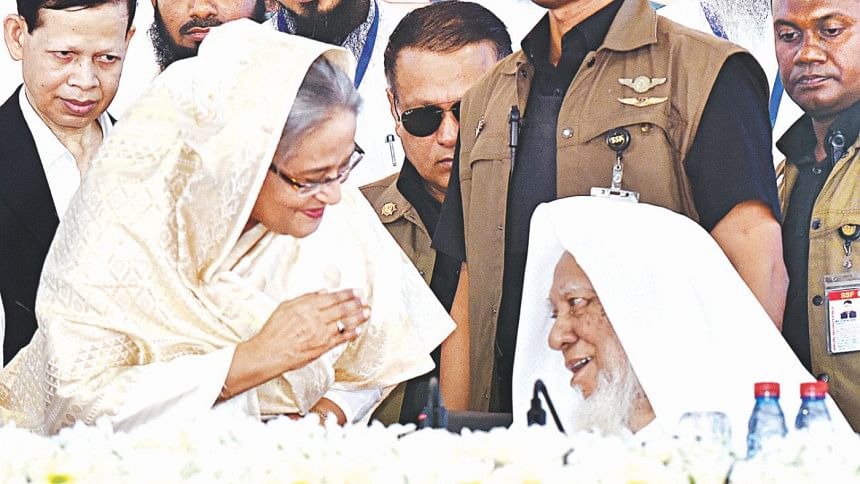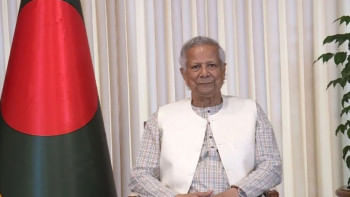What rocks Hefajat's boat?

In a grand rally, Hefajat-e-Islam, a Qawmi Madrasa-based Islamist pressure group, has recently thanked Prime Minister Sheikh Hasina for her government’s recognition of Dawrae Hadith (Takmil) Certificate in Qawmi Madrasa. Hefajat enjoys considerable support among the country’s conservative populace. Therefore, its endorsement of the current government can make a difference in the forthcoming elections.
The irony of the event was inescapable, though. Hefajat and the ruling Awami League, which is supposedly a secular entity, shared mutual animosity even just a few years ago. Since 2013, when Hefajat organised a massive rally demanding death penalty for those who insulted Islam and its prophet, the government has employed a conciliatory approach to “tame” the influential group. Not only have they overcome what once seemed like an insurmountable ideological difference but also forged a virtual alliance.
Many may find the latest twist highly surprising, but the history of Qawmi-based Islamist politics suggests otherwise. It’s a history of a never-ending power struggle, with leaders leaning towards where power lies.
While Islamist political parties, except for Jamaat-e-Islami (which Qawmi-based parties renounce), have never been politically popular, they have been an important part of the contemporary political discourse. Their true political prowess lies in their position as religious leaders and their ability to summon hundreds of thousands of madrasa students within a short period of time. While scattered in countless factions, their hardcore ideological stance has barely changed over the years and is largely identical. Hefajat’s much-criticised 13-point charter best resembled these parties’ collective ideological stance.
Hefajat-e-Islam, when at its best form in 2013, was perhaps the culmination of Qaqmi-based Islamist politics. While claiming to be apolitical, the organisation consists of several traditional Islamist political parties.
The origin
Before Chittagong-based Hathajari Madrasa and Allama Ahmad Shafi, the traditional leader of these madrasas used to be Mawlana Mohammadullah, better known as Hafezzi Huzur, who co-founded Jamia Qurania Arabia, Lalbagh.
In 1981, Hafezzi Huzur made inroads into politics by forming Bangladesh Khelafat Andolan. He contested in the two presidential elections, finishing third in 1981 and second in 1986 elections.
In Khelafat Andolan, three of his disciples, Allama Azizul Haque (popularly known as Shaikhul Hadith who once headed Jamiatul Ulama), Mufti Fazlul Haque Amini (his son-in-law) and Mawlana Fazlul Karim (Charmanai Pir) held senior positions.
After Hafezzi Huzur’s death, all of them left the party, presumably having fallen out with his sons. In 1987, they formed a new political party, Islami Shashantantra Andolon (now known as Islami Andolon). However, it took just two years for them to fell apart, once again.
In 1989, Allama Azizul Haque formed his own party, Khelafat Majlish, while Mufti Fazlul Haque Amini founded another, Islami Morcha. Mawlana Fazlul Karim, the Chormonai Pir, retained his control over Islami Andolan.
In 1990, with a view to winning some parliamentary seats, all of these parties, barring Mufti Amini’s, formed a new alliance, Islami Oikyojot (IOJ). The IOJ, while now divided into two factions, has great political sways in Hefajat-e-Islam.
Political aspiration
Unlike Jamaat-e-Islami, Qawmi-based parties haven’t been able to solidify its base, hence, couldn’t tilt the electoral politics to a significant degree.
In 1991, the IOJ managed to win just one seat in Sylhet.
In 1996, Mufti Amini, with his Islami Morcha (now Khelfat-e-Islami), joined the alliance and became its secretary-general. In 1998, Amini played an instrumental role to forge an electoral alliance with Bangladesh Nationalist Party (BNP), which caused a rift in the alliance. Islami Andolon left the IOJ, citing “the woman leadership” in BNP.
With BNP, the IOJ won four seats in total in 2001. Shortly afterwards, however, the power struggle between two factions led by the old duos, Allama Azizul Haque and Mufti Amini, resulted in the alliance being divided, with the later retaining its ties with BNP.
In 2006, Allama Azizul Haque’s Khelafat Mazlish, now out of the IOJ, formed an alliance in principle with the Awami League, the-then main opposition party. They together agreed to adhere to a five-point list, which many cite as the predecessor of Hefajat's 13-point charter. The Awami League had to take a lot of heat for this arrangement, although it later abandoned the ties. In August 2012, Allama Azizul Haque died.
Mufti Amini too died the same year, but he maintained his grip over the IOJ until his last breath. In 2011, he was put to a virtual house arrest after he was accused of sedition by making an incendiary remark regarding the Constitution.
After Amini’s death, IOJ secretary general Mawlana Abdul Latif Nezami became the chairman, while Amini’s disciple, Mufti Fayezullah, became the secretary general. They were instrumental in organising the Hefajat's 2013 rally. In January 2016, they withdrew IOJ from the BNP-led 20-party alliance, presumably under the government's pressure.
Ideological differences
While relatively indifferent to matters of public interest, these parties thrive upon religiously emotive issues.
For example, in 1993, Allama Azizul Haque and Mufti Fazlul Haque Amini came into prominence by leading a long march protest over the demolition of Babri Masjid in India. The next year they fomented protests against writer Taslima Nasrin, forcing her to flee the country, which made international headlines.
In February 2001, the IOJ took to the streets against a High Court verdict banning fatwa. These parties have long demanded to declare Ahmadiya community as non-Muslim and formulate a blasphemy law. In addition, they have taken issues with secularism, secular education policy, sculptures, candle-lighting, atheism, the depiction of Prophet Muhammad (pbuh), the portrayal of religious leaders in the mass media, mixing of males and females, etc.
These parties seem to have an issue with women, too. In 2009, for example, Mufti Amini harshly criticised the government's “Women Development Policy” as anti-Islamic. In fact, many believe the agitation over the issue resulted in Hefajat-e-Islam, which remained in hibernation until 2013. Several incendiary remarks of Allama Shafi, the chief of Hefajat, about women also caused an uproar. The government's insistence on lowering the age requirement for girls' marriage was also in line with Hefajat's demands.
While the AL government initially resisted those demands, the authorities have recently acted favourably to these groups. For example, the textbooks were significantly changed to conform to their demands. In April 2017, when the then Chief Justice, Surendra Kumar Sinha, installed a statue of Lady Justice in front of the Supreme Court, a group of Islamist parties waged protests. The prime minister supported their calls, forcing the chief justice to relocate the statue to a less prominent position.
Declining credibility?
Unlike in 2006, when Awami League's apparent ties with Khelafat Majlish upset the party’s secular supporter base, the close proximity between Hefajat and AL has been met with silent approval from many of the latter’s supporters, who see the association as a political necessity. Ironically, the group that’s taking heat from their supporters this time is Hefajat.
While enthusiastically attended by its chief Allama Shafi, a number of influential leaders—including its senior vice president, the secretary and several vice presidents, and Dhaka unit chief—of the group abstained from the ‘thanksgiving’ rally. Both Muhibullah Babunagari, the senior vice president, and Zunaid Babunagari, the secretary general, released separate scathing public statements before and after the rally.
As indicated by the internal infighting, Hefajat may soon face a split andfind many of its supporters disillusioned with it, in particular, and religion based politics, in general.
Nazmul Ahasan is a member of the editorial team at The Daily Star.

 For all latest news, follow The Daily Star's Google News channel.
For all latest news, follow The Daily Star's Google News channel. 



Comments